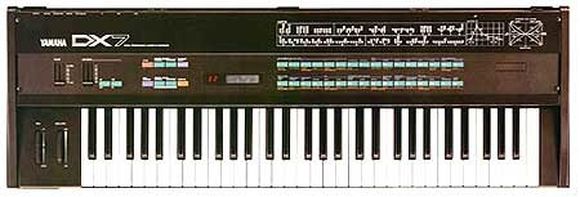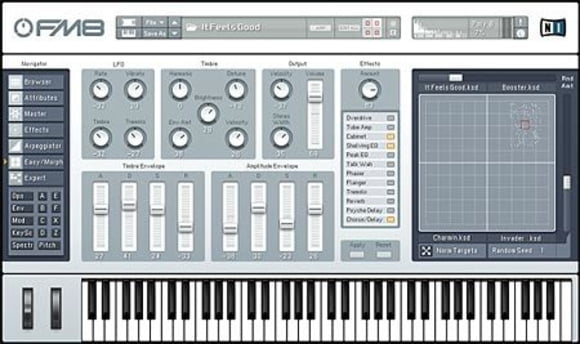4. FM-Synthesizer
The first mainstream commercial FM synthesizer was the Yamaha DX7 which debuted in 1983, and was 16-note polyphonic, with 32 patch memories and a ROM/RAM cartridge slot. In those days, analogue synthesizers in the same price bracket such as the Juno 6 had a maximum of 6-note polyphony. Even leviathans like the Sequential T1 could produce only 10 notes at most. The DX7 was far cheaper, could produce 16 notes, and was fully digital, with a radically different sound to anything that had gone before.

Yamaha DX7 FM synthesizer
The FM (Frequency Modulation) in FM tone generators such as the DX7 is based on the same principal as FM broadcasting - an electrical wave called the carrier is modulated by another called the modulator, and this combined signal faithfully conveys the original content of the broadcast when decoded. The difference is that the FM used in synthesizers lowers these waves to audible frequencies, and the decoding is dispensed with. Unlike analogue synthesizers, where the waveforms (saw, square, sine etc) are often the main focus of the controls, FM, like additive synthesis (a rare type which uses multiple sine waves to recreate sounds), is much more concerned with harmonics/partials and the spectrum of the sound.
The basic structure is a series of identical components called operators. Each operator has the software equivalent of its own oscillator, amplifier and envelope. An operator can be used as a sound source (carrier) or as a modulator. The carrier signal determines the pitch of the note produced, and the modulator determines the shape or timbre. When a low frequency output from the modulator is fed into the carrier, it produces a tremolo effect by slowly changing the carrier's level over time, as we would get with normal subtractive modulation of an oscillator's amplitude. But if the frequency of the modulator is increased into the audible range, then the type of sound produced is determined by how the modulator's frequency relates to the carrier harmonically, if at all. Injecting a harmonically related signal generates harmonics that sound more in-tune. The amount of harmonics produced is dependent on the level of the signal injected into the main oscillator. The amount of modulation or volume level applied to the second oscillator is commonly known as the modulation index. If we increase the modulation index of a sinewave that is modulating another sinewave, the resulting waveform changes from a sinewave at modulation index 0, through an increasingly more complex and bright waveform, to noise at a very high modulation index. The change to noise is quite sudden, and this can be used in many creative ways.
Because of the nature of FM synthesis, a method of providing flexible routing between operators was needed, so as to enable the programming of a wide range of timbres. This was achieved by grouping the operators into preset Algorithms. The DX7 had 32 different Algorithms, each consisting of up to 6 operators.
Native Instruments contemporary FM8 software synthesizer allows you to create any number of algorithms using a programming matrix. Multiple carrier operators can be routed to the output, each connected to its own independent modulators. Algorithms can then be stored for later recall as the structure of another sound.

Native Instruments FM8 FM synthesizer software
Like the original envelope generators in the DX series, FM8s Time/Level envelopes allow you to specify both the level of each stage of the envelope, and the time it takes to get from one stage to the next. In addition you can define how many stages you want in total by creating your own breakpoints - highly flexible!




